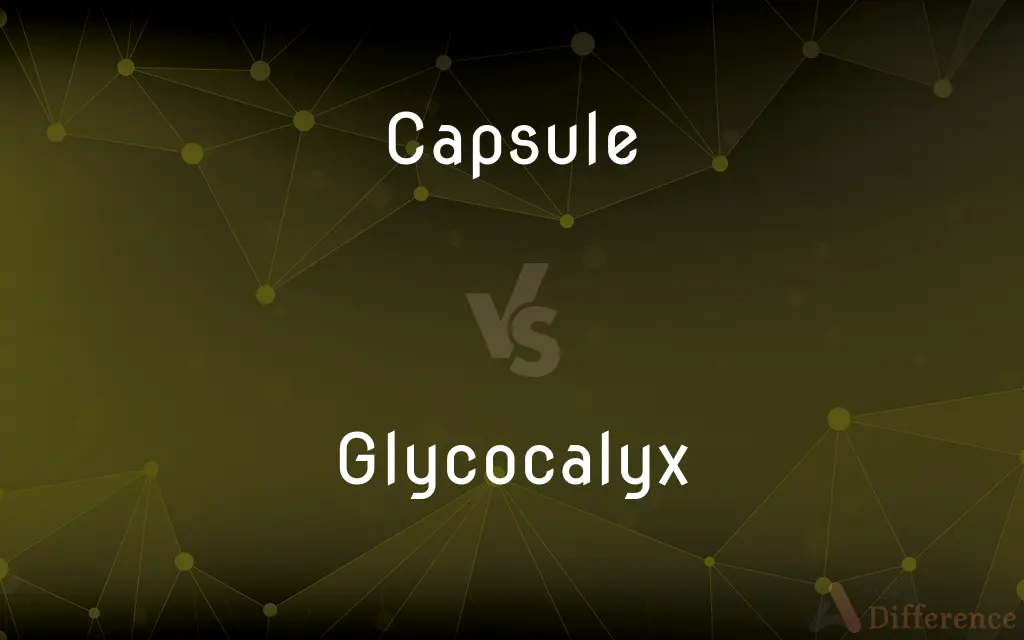Capsule vs. Glycocalyx — What's the Difference?
By Urooj Arif & Fiza Rafique — Updated on March 19, 2024
A capsule is a polysaccharide layer that surrounds some bacteria, offering protection and aiding in evasion from host immune systems. Glycocalyx is a carbohydrate-enriched coating present on the outer surface of both prokaryotic and eukaryotic cells.

Difference Between Capsule and Glycocalyx
Table of Contents
ADVERTISEMENT
Key Differences
The bacterial capsule is a distinct, gelatinous layer that envelops the cell wall, providing a barrier against phagocytosis and environmental stresses, such as dehydration or antibiotic action. It is particularly important in pathogenic bacteria, enhancing their ability to cause disease by preventing detection and destruction by the host's immune system. In contrast, the glycocalyx is a more generalized term referring to the extracellular polymeric material covering cell surfaces. In bacteria, it can include the capsule when present, but in eukaryotic cells, the glycocalyx consists of glycoproteins and glycolipids that contribute to cell-cell recognition, adhesion, and protection.
Capsules are composed primarily of polysaccharides, but can sometimes contain polypeptides, and their production is often associated with pathogenic bacteria. The glycocalyx, however, is made up of a variety of molecules, including carbohydrates, proteins, and lipids, contributing to a diverse range of functions beyond protection, such as cell communication and the immune response.
In terms of function, the bacterial capsule is specifically adapted for protection and evasion within the context of a host-pathogen interaction, making it a key factor in the virulence of pathogenic bacteria. The glycocalyx's functions are broader, encompassing cell recognition, adhesion (such as in the formation of biofilms by bacteria), and protection in a wide array of biological contexts, including but not limited to pathogenesis.
While the capsule is a feature that is not present in all bacteria and is mostly associated with pathogenic strains, the glycocalyx is a ubiquitous feature of all cells, highlighting its fundamental role in cell biology across both prokaryotes and eukaryotes.
Comparison Chart
Composition
Primarily polysaccharides, sometimes polypeptides
Carbohydrates (glycoproteins and glycolipids), proteins, and lipids
ADVERTISEMENT
Location
Surrounds the cell wall in some bacteria
Outer surface of prokaryotic and eukaryotic cells
Function
Protects bacteria from phagocytosis and environmental stresses, aids in immune evasion
Protection, cell-cell recognition, adhesion, and immune response
Association with Pathogenicity
Often associated with pathogenic bacteria, enhancing virulence
Involved in a wide range of functions, not solely associated with pathogenicity
Presence
Not present in all bacteria, mostly in pathogenic strains
Ubiquitous in all cells, fundamental to cell biology
Compare with Definitions
Capsule
A protective layer surrounding some bacterial cell walls.
The capsule helps the bacterium evade the host's immune system.
Glycocalyx
A carbohydrate-rich coating on cell surfaces.
The glycocalyx plays a crucial role in cell-cell recognition and adhesion.
Capsule
Provides defense against environmental factors.
The bacterial capsule protects against dehydration and antibiotics.
Glycocalyx
Present in both prokaryotic and eukaryotic cells.
The eukaryotic cell's glycocalyx is involved in protective and communicative functions.
Capsule
Composed mainly of polysaccharides, aiding in pathogenicity.
The polysaccharide capsule is a key virulence factor in certain bacteria.
Glycocalyx
Composed of glycoproteins and glycolipids.
The diverse components of the glycocalyx contribute to its multifunctional nature.
Capsule
Specific to bacterial cells, contributing to immune evasion.
The capsule prevents phagocytosis by immune cells.
Glycocalyx
Involved in a broad range of biological functions.
The glycocalyx facilitates immune responses and cell signaling.
Capsule
Not found in all bacteria, associated with pathogenic strains.
Pathogenic bacteria often possess a capsule to enhance their survival in the host.
Glycocalyx
Ubiquitous and fundamental to cell biology.
The presence of a glycocalyx is a universal feature among cells, highlighting its importance.
Capsule
A small soluble container, usually made of gelatin, that encloses a dose of an oral medicine or a vitamin.
Glycocalyx
The glycocalyx, also known as the pericellular matrix, is a glycoprotein and glycolipid covering that surrounds the cell membranes of some bacteria, epithelia, and other cells. In 1970, Martinez-Palomo discovered the cell coating in animal cells, which is known as the glycocalyx.
Capsule
(Anatomy) A fibrous, membranous, or fatty sheath that encloses an organ or part, such as the sac surrounding the kidney or the fibrous tissues that surround a joint.
Glycocalyx
A filamentous coating of glycoprotein and polysaccharide on the surface of bacteria and some other cells.
Capsule
(Microbiology) A polysaccharide outer shell enveloping certain bacteria.
Capsule
A dry dehiscent fruit that develops from two or more united carpels.
Capsule
The thin-walled, spore-containing structure of mosses and related plants.
Capsule
A space capsule.
Capsule
A brief summary; a condensation.
Capsule
Highly condensed; very brief
A capsule description.
Capsule
Very small; compact.
Capsule
To enclose in or furnish with a capsule.
Capsule
To condense or summarize
Capsuled the news.
Capsule
(physiology) A membranous envelope.
Capsule
(botany) A type of simple, dehiscent, dry fruit (seed-case) produced by many species of flowering plants, such as poppy, lily, orchid, willow and cotton.
Capsule
(botany) A sporangium, especially in bryophytes.
Capsule
(anatomy) A tough, fibrous layer surrounding an organ such as the kidney or liver
Capsule
(anatomy) A membrane that surrounds the eyeball
Capsule
(astronautics) A detachable part of a rocket or spacecraft (usually in the nose) containing the crew's living space.
Capsule
(pharmacy) A small container containing a dose of medicine.
Capsule
In a brief, condensed or compact form
Capsule
(winemaking) The covering — formerly lead or tin, now often plastic — over the cork at the top of the wine bottle.
Capsule
A small clay saucer for roasting or melting samples of ores, etc.; a scorifier.
Capsule
A small, shallow evaporating dish, usually of porcelain.
Capsule
A small cup or shell, often of metal, for a percussion cap, cartridge, etc.
Capsule
(transitive) To form (medicine, etc.) into capsules.
Capsule
(transitive) To encapsulate or summarize.
Capsule
A dry fruit or pod which is made up of several parts or carpels, and opens to discharge the seeds, as, the capsule of the poppy, the flax, the lily, etc.
Capsule
A small saucer of clay for roasting or melting samples of ores, etc.; a scorifier.
Capsule
A small cylindrical or spherical gelatinous envelope in which nauseous or acrid doses are inclosed to be swallowed.
Capsule
A membranous sac containing fluid, or investing an organ or joint; as, the capsule of the lens of the eye. Also, a capsulelike organ.
Capsule
A metallic seal or cover for closing a bottle.
Capsule
A small cup or shell, as of metal, for a percussion cap, cartridge, etc.
Capsule
A small container
Capsule
A pill in the form of a small rounded gelatinous container with medicine inside
Capsule
A dry dehiscent seed vessel or the spore-containing structure of e.g. mosses
Capsule
A shortened version of a written work
Capsule
A structure that encloses a body part
Capsule
A spacecraft designed to transport people and support human life in outer space
Capsule
A pilot's seat in an airplane that can be forcibly ejected in the case of an emergency; then the pilot descends by parachute
Capsule
Enclose in a capsule
Capsule
Put in a short or concise form; reduce in volume;
Capsulize the news
Common Curiosities
How does the glycocalyx contribute to cellular functions?
It plays roles in protection, cell-cell recognition, adhesion, and immune responses, contributing to a cell's ability to interact with its environment.
What is the significance of the glycocalyx in human health?
It's crucial for various bodily functions, including immune defense, cell signaling, and tissue integrity. Its disruption can lead to diseases.
What is the primary function of a bacterial capsule?
The primary function is to protect bacteria from environmental stresses and host immune responses, aiding in pathogenicity.
How does the composition of the capsule and glycocalyx differ?
The capsule is primarily made of polysaccharides, sometimes polypeptides, while the glycocalyx includes a mix of carbohydrates, proteins, and lipids.
Can a capsule be found on eukaryotic cells?
No, capsules are specific to some bacteria, particularly pathogenic strains, and are not found on eukaryotic cells.
How is the glycocalyx involved in bacterial infections?
In bacteria, it can aid in adhesion to host tissues and biofilm formation, contributing to infection and resistance to treatment.
Can the glycocalyx be found in plant cells?
Yes, plant cells also have a glycocalyx that plays roles in protection, interaction with the environment, and cell-cell recognition.
Do all cells have a glycocalyx?
Yes, all prokaryotic and eukaryotic cells have some form of a glycocalyx, though its composition and thickness can vary widely.
Are all bacteria with capsules pathogenic?
While many pathogenic bacteria have capsules, not all bacteria with capsules are pathogenic, and not all pathogenic bacteria have capsules.
Is the capsule visible under a microscope?
Yes, capsules can often be visualized using specific staining techniques that contrast them against the cell and the background.
How are capsules and the glycocalyx studied in microbiology?
They are studied through biochemical analysis, microscopy techniques, and genetic studies to understand their composition, function, and role in disease.
What role does the glycocalyx play in organ transplantation?
It's involved in cell recognition and immune response, affecting graft acceptance and the risk of transplant rejection.
How do capsules and the glycocalyx differ in their role in immune evasion?
Capsules directly help bacteria evade immune detection, while the glycocalyx's role in immune evasion is more varied and not solely focused on evasion.
Share Your Discovery

Previous Comparison
Aluminium vs. Alumina
Next Comparison
India vs. CanadaAuthor Spotlight
Written by
Urooj ArifUrooj is a skilled content writer at Ask Difference, known for her exceptional ability to simplify complex topics into engaging and informative content. With a passion for research and a flair for clear, concise writing, she consistently delivers articles that resonate with our diverse audience.
Co-written by
Fiza RafiqueFiza Rafique is a skilled content writer at AskDifference.com, where she meticulously refines and enhances written pieces. Drawing from her vast editorial expertise, Fiza ensures clarity, accuracy, and precision in every article. Passionate about language, she continually seeks to elevate the quality of content for readers worldwide.














































